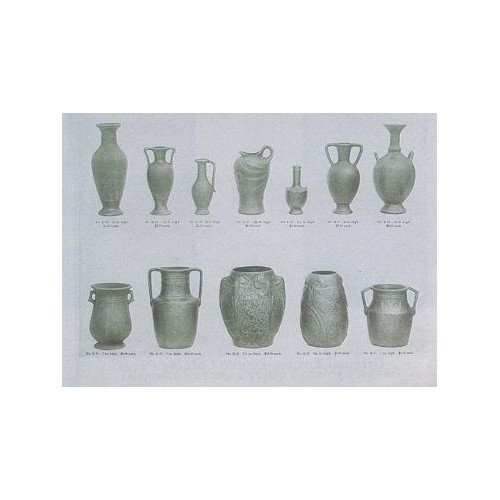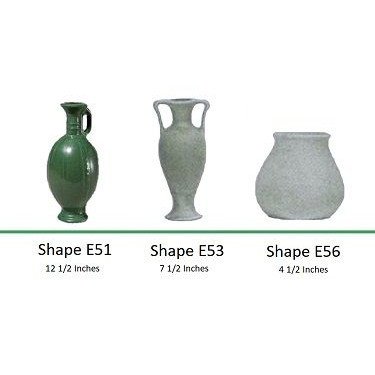
Collectors Guide to Roseville Pottery Rozane Egypto, 1905-1907
What is Egypto?
Egypto is a line of art pottery produced in 1905-1907 by the Roseville Pottery Company in Zanesville, Ohio.
Who designed Egypto?
The Egypto line was likely designed by Frederick Rhead.
After having every entry in the 1904 St. Louis World Fair rejected by the judges, Roseville began developing a new approach towards the art pottery they offered. The new products were focused around what was successful there. The famous matt green of the Grueby Pottery led Roseville to expand upon their existing Chloron Line, creating Rozane Egypto. Seven shapes were borrowed from Chloron, changing only the designation from a "C" to an "E". Chloron shape "C10" became Egypto shape "E10", and so on. The seven shapes were: E10, E12, E15, E17, E19, E20, and E21. Shape C11 was repurposed for the Mara line, and a new form was created specifically for the Egypto shape E11. The total number of shapes in the Egypto line is believed to be over 40.
All Egypto is marked with the Rozane/Egypto wafer on the base. For decades collectors have believed that dozens of additional pieces were "unmarked Egypto", however, research has determined that these pieces are actually either the early "Mat Green" or later "Matt Green". One glaring example is the mat green elephant oil lamp often described as egypto. It was later produced as Egypto and with the Rozane/Egypto wafer, but unmarked it is from the Mat Green Line. It is also important to note that there were no umbrella stands, nor any jardiniere and pedestal sets in the Egypto line.
The glaze used on Egypto was no different from the original matt green, which could be smooth or variegated depending on the application. The designs were not really classic Egyptian in form, but some clearly had Persian influences. The exotic nature of the forms seemed to conjure the impression of more ancient forms, even if they were not technically correct to any culture or time period.
When was Egypto made?
The Egypto line was only produced in 1905-1907.
Roseville Egypto was seen as one of the five pillars of their new Rozane marketing strategy, intended to capture market share of the emerging matt green-glazed arts and crafts movement. The other four were Woodland, Mara, Mongol, and Royal.
Below are the shapes offered in the Roseville Pottery Egypto line.
-

Roseville Egypto Wafer
-

Egypto Catalog Page 1
-

Egypto Catalog Page 2
-

Egypto Catalog Page 3
-

Egypto Shapes E10, E11, E12
-

Egypto Shapes E15, E17, E19
-

Egypto Shapes E20, E21, E29
-

Egypto Shapes E30, E31, E32
-

Egypto Shapes E33, E34, E35
-

Egypto Shapes E36, E37, E38
-

Egypto Shapes E39, E40, E41
-

Egypto Dhapes E42, E43, E44
-

Egypto Shapes E45, E46, E47
-

Egypto Shapes E48, E49, E50
-

Egypto Shapes E51, E53, E56
-

Egypto Shapes E57, E58, E59
-

Egypto Shapes E62, E64, E68
-

Egypto Unknown Shapes
-

Egypto in Rozane Brochure 1
-

Egypto in Rozane Brochure 2
-

Egypto in Rozane Brochure 3

The following is the text of the 1905 Rozane pamphlet describing the Rozane Egypto line:
Rozane Egypto: Thought made Permanent in Pottery
All Rozane being the creations of individual artists, who bring their own wonderful talent and skill into the expression of their ideas of form, color and design, it is only natural that some very unusual products should be the result.
Rozane Egypto may be classed as one of the oddest styles of Rozane, although its soft finish and coloring, in various shades of old green, suggest a very beautiful color found in some of the rarest and most ancient potteries of old Egypt. The shapes and decorations, too, are reproductions of Egyptian art antiques.
Each piece of Rozane Egypto expresses a complete thought of its artist, savoring of the restfulness and freedom of nature. Through the shades of old green are seen the glinting of those rich violets and blues which often entered into the coloring of the rarest old Egyptian pieces. The prevailing color of these latter was a green which came to be almost as famous as the old red of the Chinese.
Rozane Egypto is indispensable in a collection of Rozanes or any pottery. Not only is the color in itself peculiarly attractive and restful, but the forms of this variety, like all Rozanes, are graceful and well proportioned. The low modelings of mat decoration too, retaining the prevailing hues, contribute effectively to its beauty.
A touch of green in a room is never amiss - such greens, soft and harmonious, as Egypto presents. As a container of flowers, a piece of this ware is most charming. The fascination of an Egypto bowl or jar containing a mass of nasturtiums, their flaming blossoms seen against the perfect green background of the vase, can hardly be described.
Egypto is well suited, as a background, for almost any flower, and is therefore as useful and practical as it is beautiful. It is ideal in rooms where colonial and other old-style decorative schemes are carried out.
In many ways, Rozane Egypto may be regarded as an ideal pottery.
"The entire vitality of art depends upon its being either full of truth or full of use." says Ruskin. "It must state a true thing or adorn a useful one." Rozane Egypto does both.
The ceramic is the union of two branches of art, the architectural and the graphic. It combines form and proportion with drawing and color. In the architectural, is demanded skill, beauty and use; in the graphic, skill, beauty, and likeness. Essentials of the best in ceramic art are, therefore, skill, beauty, use and similitude (statement of truth), according to best authority.
Rozane Egypto meets every one of these requirements to the complete satisfaction of good ceramic judges, placing it at once among the very best potteries of the age.
If you have more questions, we are certain you will find the answers in the following books. Each of these books is highly recommended for collectors of Roseville Pottery. The owners of this website may receive compensation for qualified sales of the books.




